Digital Strategy Implementation: Resources & Metrics - Juhayna Foods
VerifiedAdded on 2023/06/07
|10
|2280
|399
Report
AI Summary
This report delves into the resources necessary for Juhayna Food Industries to effectively implement digital marketing strategies, emphasizing the importance of skilled human resources, website updates, IT infrastructure, and social media engagement. It identifies key metrics and methods, including traffic, conversion, and revenue metrics, to measure the effectiveness of these strategies, such as site visits, conversion rates, and return on investment. The report also outlines the process of measuring and controlling digital marketing activities, highlighting the need for clear objectives, target setting, and performance monitoring to ensure a competitive edge and sustainability in the market. The analysis includes costs associated with each resource and activity, providing a comprehensive overview of Juhayna's digital marketing efforts.
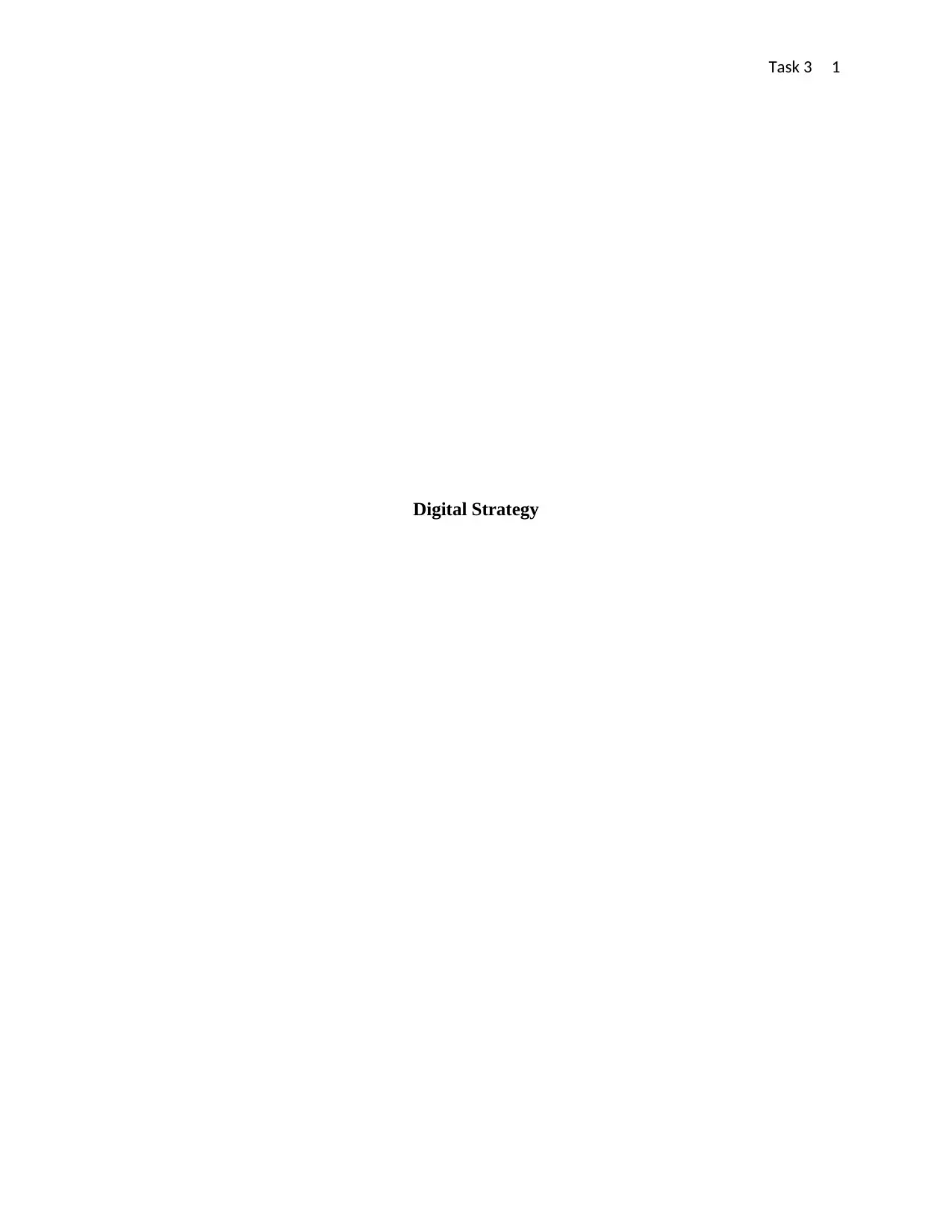
Task 3 1
Digital Strategy
Digital Strategy
Paraphrase This Document
Need a fresh take? Get an instant paraphrase of this document with our AI Paraphraser
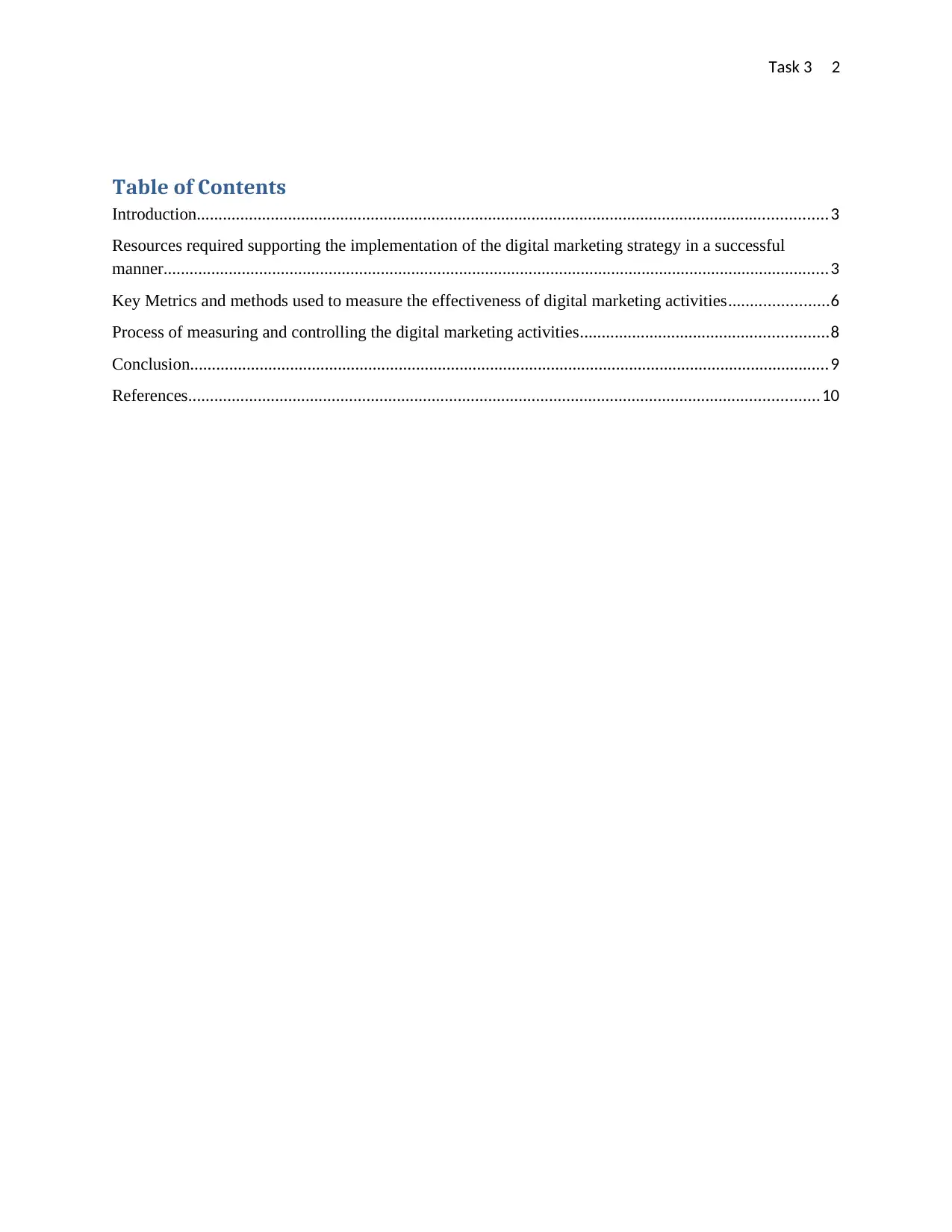
Task 3 2
Table of Contents
Introduction.................................................................................................................................................3
Resources required supporting the implementation of the digital marketing strategy in a successful
manner.........................................................................................................................................................3
Key Metrics and methods used to measure the effectiveness of digital marketing activities.......................6
Process of measuring and controlling the digital marketing activities.........................................................8
Conclusion...................................................................................................................................................9
References.................................................................................................................................................10
Table of Contents
Introduction.................................................................................................................................................3
Resources required supporting the implementation of the digital marketing strategy in a successful
manner.........................................................................................................................................................3
Key Metrics and methods used to measure the effectiveness of digital marketing activities.......................6
Process of measuring and controlling the digital marketing activities.........................................................8
Conclusion...................................................................................................................................................9
References.................................................................................................................................................10
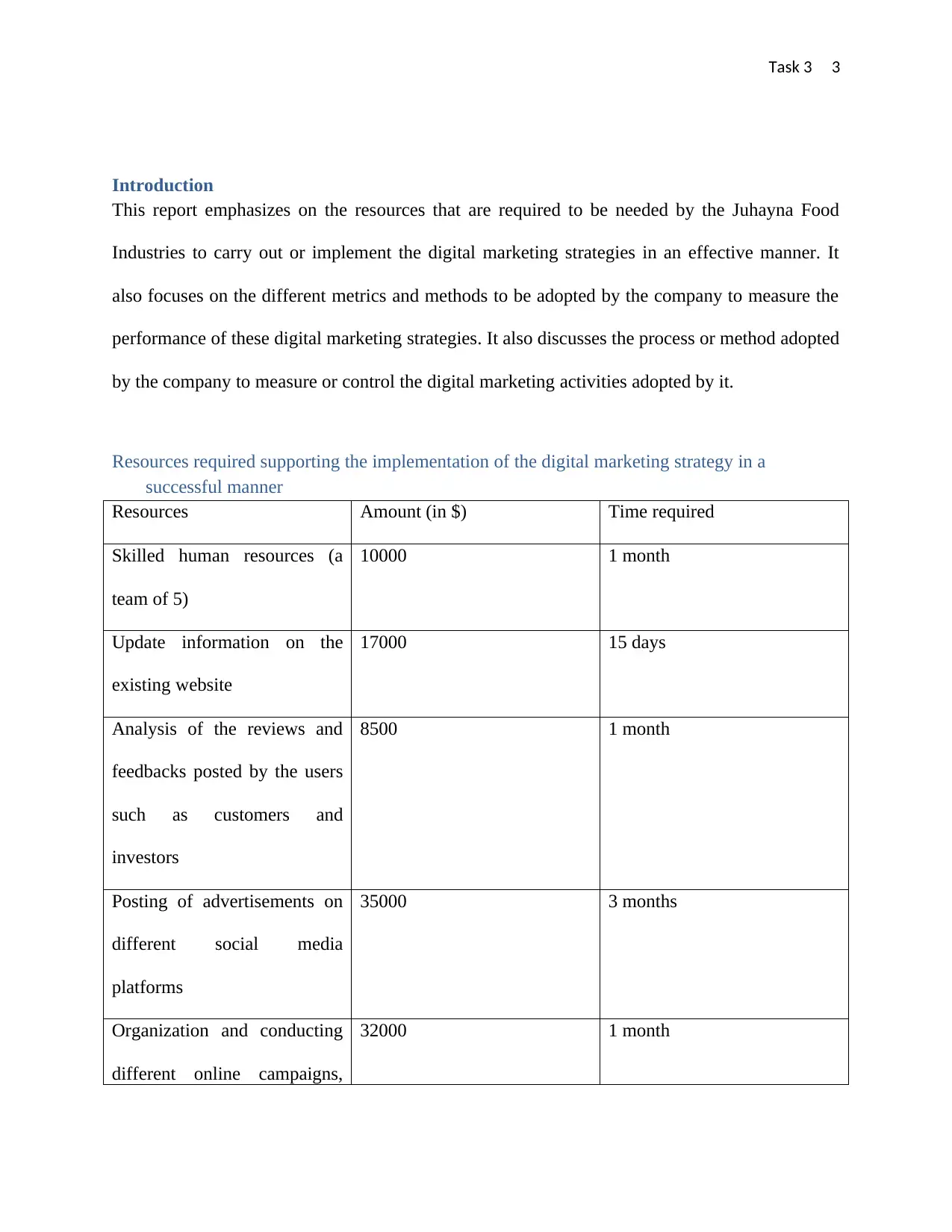
Task 3 3
Introduction
This report emphasizes on the resources that are required to be needed by the Juhayna Food
Industries to carry out or implement the digital marketing strategies in an effective manner. It
also focuses on the different metrics and methods to be adopted by the company to measure the
performance of these digital marketing strategies. It also discusses the process or method adopted
by the company to measure or control the digital marketing activities adopted by it.
Resources required supporting the implementation of the digital marketing strategy in a
successful manner
Resources Amount (in $) Time required
Skilled human resources (a
team of 5)
10000 1 month
Update information on the
existing website
17000 15 days
Analysis of the reviews and
feedbacks posted by the users
such as customers and
investors
8500 1 month
Posting of advertisements on
different social media
platforms
35000 3 months
Organization and conducting
different online campaigns,
32000 1 month
Introduction
This report emphasizes on the resources that are required to be needed by the Juhayna Food
Industries to carry out or implement the digital marketing strategies in an effective manner. It
also focuses on the different metrics and methods to be adopted by the company to measure the
performance of these digital marketing strategies. It also discusses the process or method adopted
by the company to measure or control the digital marketing activities adopted by it.
Resources required supporting the implementation of the digital marketing strategy in a
successful manner
Resources Amount (in $) Time required
Skilled human resources (a
team of 5)
10000 1 month
Update information on the
existing website
17000 15 days
Analysis of the reviews and
feedbacks posted by the users
such as customers and
investors
8500 1 month
Posting of advertisements on
different social media
platforms
35000 3 months
Organization and conducting
different online campaigns,
32000 1 month
⊘ This is a preview!⊘
Do you want full access?
Subscribe today to unlock all pages.

Trusted by 1+ million students worldwide
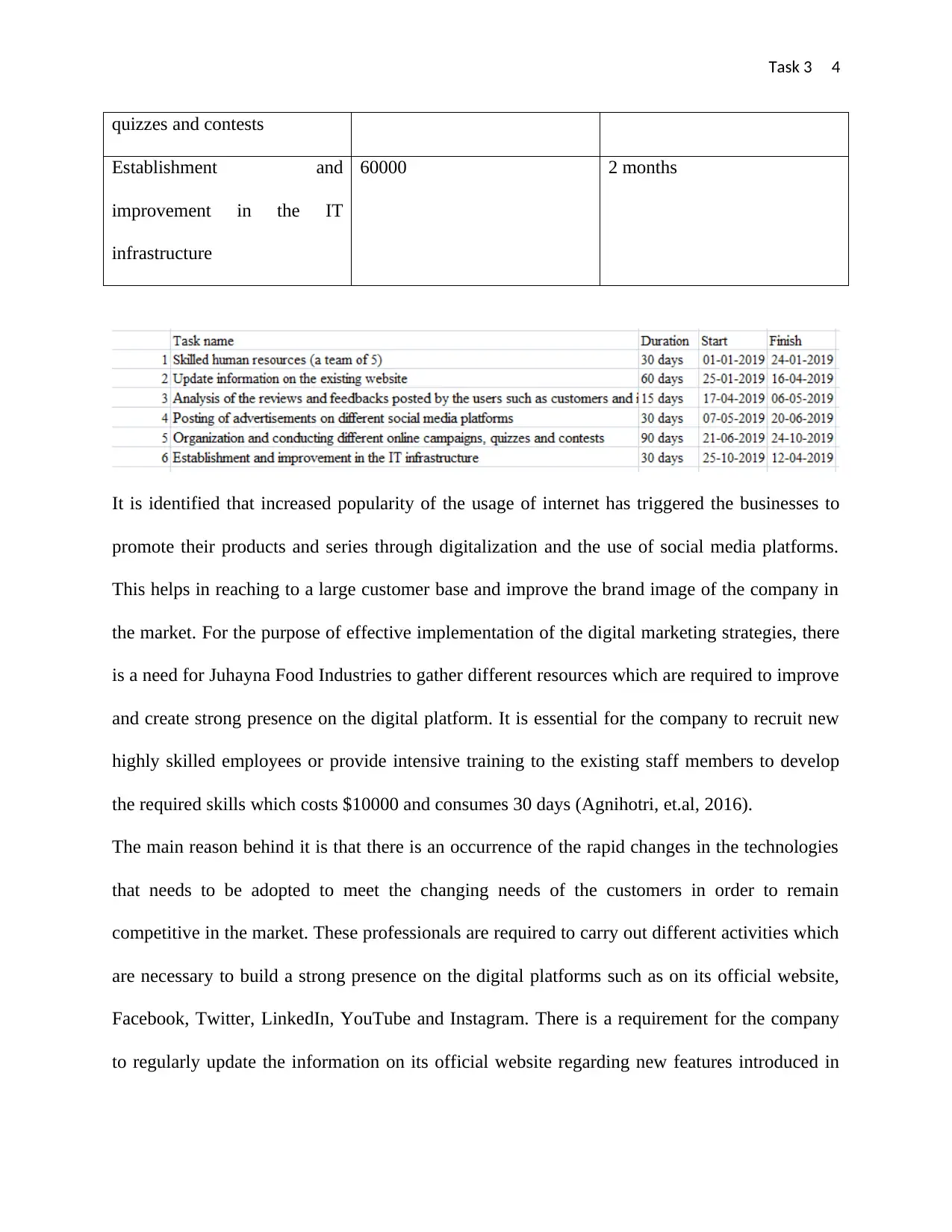
Task 3 4
quizzes and contests
Establishment and
improvement in the IT
infrastructure
60000 2 months
It is identified that increased popularity of the usage of internet has triggered the businesses to
promote their products and series through digitalization and the use of social media platforms.
This helps in reaching to a large customer base and improve the brand image of the company in
the market. For the purpose of effective implementation of the digital marketing strategies, there
is a need for Juhayna Food Industries to gather different resources which are required to improve
and create strong presence on the digital platform. It is essential for the company to recruit new
highly skilled employees or provide intensive training to the existing staff members to develop
the required skills which costs $10000 and consumes 30 days (Agnihotri, et.al, 2016).
The main reason behind it is that there is an occurrence of the rapid changes in the technologies
that needs to be adopted to meet the changing needs of the customers in order to remain
competitive in the market. These professionals are required to carry out different activities which
are necessary to build a strong presence on the digital platforms such as on its official website,
Facebook, Twitter, LinkedIn, YouTube and Instagram. There is a requirement for the company
to regularly update the information on its official website regarding new features introduced in
quizzes and contests
Establishment and
improvement in the IT
infrastructure
60000 2 months
It is identified that increased popularity of the usage of internet has triggered the businesses to
promote their products and series through digitalization and the use of social media platforms.
This helps in reaching to a large customer base and improve the brand image of the company in
the market. For the purpose of effective implementation of the digital marketing strategies, there
is a need for Juhayna Food Industries to gather different resources which are required to improve
and create strong presence on the digital platform. It is essential for the company to recruit new
highly skilled employees or provide intensive training to the existing staff members to develop
the required skills which costs $10000 and consumes 30 days (Agnihotri, et.al, 2016).
The main reason behind it is that there is an occurrence of the rapid changes in the technologies
that needs to be adopted to meet the changing needs of the customers in order to remain
competitive in the market. These professionals are required to carry out different activities which
are necessary to build a strong presence on the digital platforms such as on its official website,
Facebook, Twitter, LinkedIn, YouTube and Instagram. There is a requirement for the company
to regularly update the information on its official website regarding new features introduced in
Paraphrase This Document
Need a fresh take? Get an instant paraphrase of this document with our AI Paraphraser
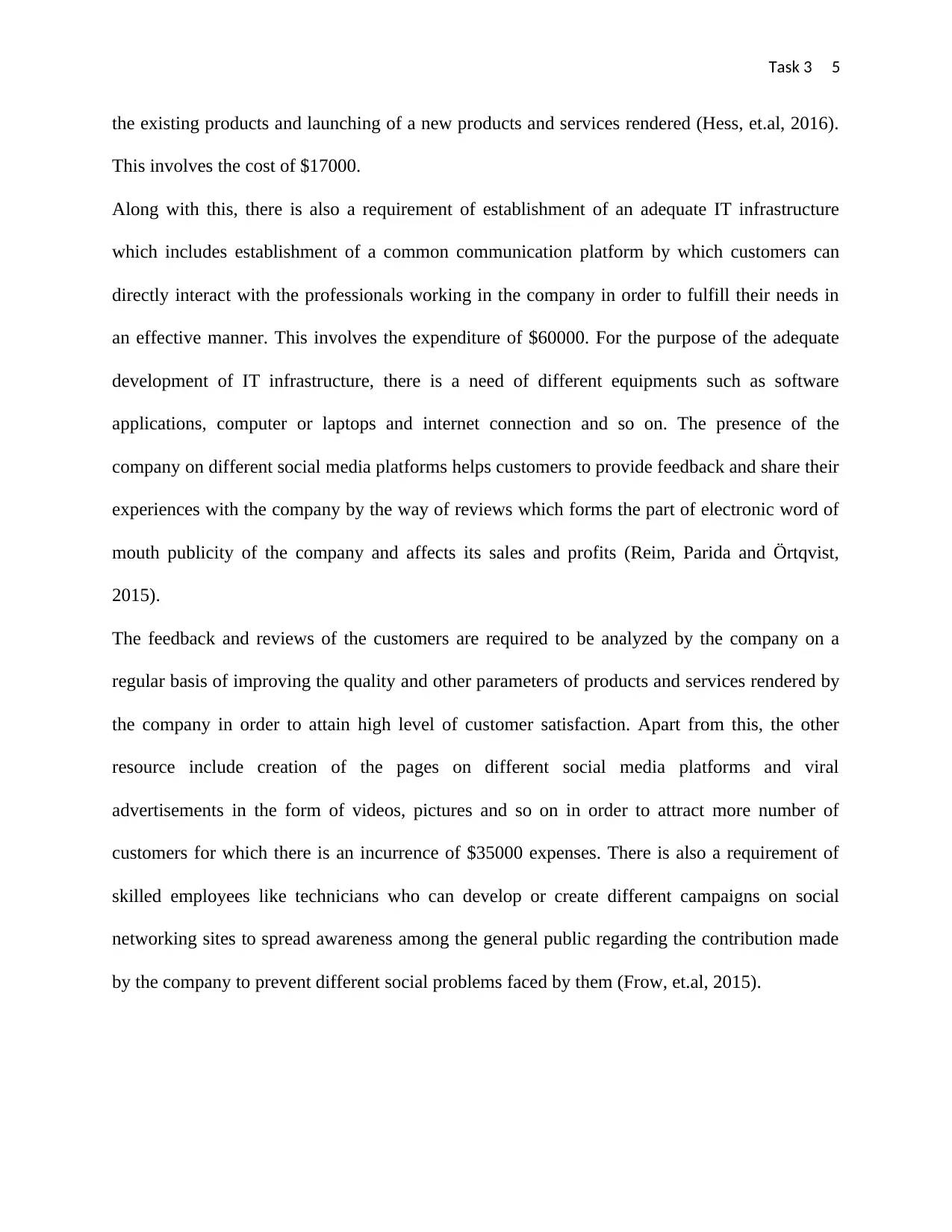
Task 3 5
the existing products and launching of a new products and services rendered (Hess, et.al, 2016).
This involves the cost of $17000.
Along with this, there is also a requirement of establishment of an adequate IT infrastructure
which includes establishment of a common communication platform by which customers can
directly interact with the professionals working in the company in order to fulfill their needs in
an effective manner. This involves the expenditure of $60000. For the purpose of the adequate
development of IT infrastructure, there is a need of different equipments such as software
applications, computer or laptops and internet connection and so on. The presence of the
company on different social media platforms helps customers to provide feedback and share their
experiences with the company by the way of reviews which forms the part of electronic word of
mouth publicity of the company and affects its sales and profits (Reim, Parida and Örtqvist,
2015).
The feedback and reviews of the customers are required to be analyzed by the company on a
regular basis of improving the quality and other parameters of products and services rendered by
the company in order to attain high level of customer satisfaction. Apart from this, the other
resource include creation of the pages on different social media platforms and viral
advertisements in the form of videos, pictures and so on in order to attract more number of
customers for which there is an incurrence of $35000 expenses. There is also a requirement of
skilled employees like technicians who can develop or create different campaigns on social
networking sites to spread awareness among the general public regarding the contribution made
by the company to prevent different social problems faced by them (Frow, et.al, 2015).
the existing products and launching of a new products and services rendered (Hess, et.al, 2016).
This involves the cost of $17000.
Along with this, there is also a requirement of establishment of an adequate IT infrastructure
which includes establishment of a common communication platform by which customers can
directly interact with the professionals working in the company in order to fulfill their needs in
an effective manner. This involves the expenditure of $60000. For the purpose of the adequate
development of IT infrastructure, there is a need of different equipments such as software
applications, computer or laptops and internet connection and so on. The presence of the
company on different social media platforms helps customers to provide feedback and share their
experiences with the company by the way of reviews which forms the part of electronic word of
mouth publicity of the company and affects its sales and profits (Reim, Parida and Örtqvist,
2015).
The feedback and reviews of the customers are required to be analyzed by the company on a
regular basis of improving the quality and other parameters of products and services rendered by
the company in order to attain high level of customer satisfaction. Apart from this, the other
resource include creation of the pages on different social media platforms and viral
advertisements in the form of videos, pictures and so on in order to attract more number of
customers for which there is an incurrence of $35000 expenses. There is also a requirement of
skilled employees like technicians who can develop or create different campaigns on social
networking sites to spread awareness among the general public regarding the contribution made
by the company to prevent different social problems faced by them (Frow, et.al, 2015).
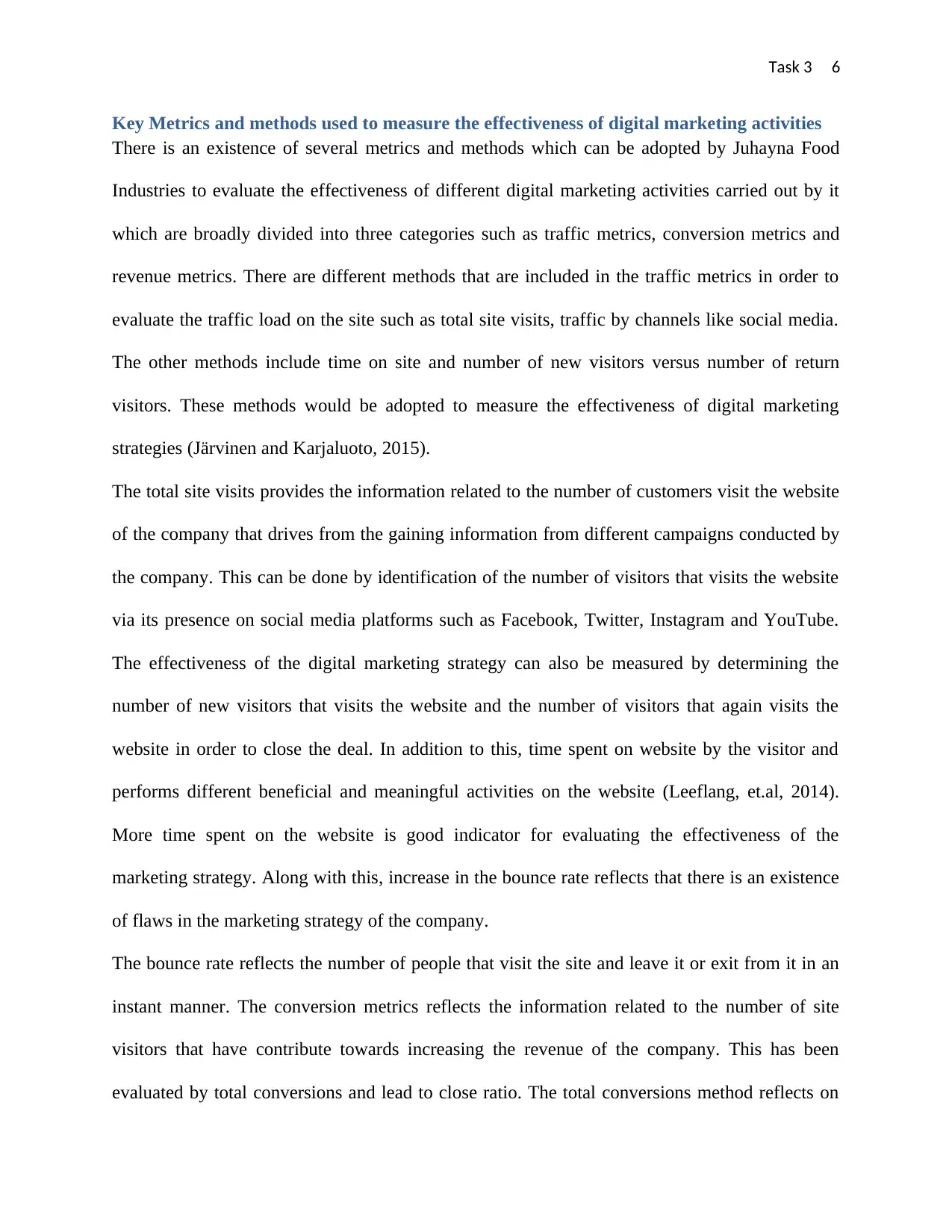
Task 3 6
Key Metrics and methods used to measure the effectiveness of digital marketing activities
There is an existence of several metrics and methods which can be adopted by Juhayna Food
Industries to evaluate the effectiveness of different digital marketing activities carried out by it
which are broadly divided into three categories such as traffic metrics, conversion metrics and
revenue metrics. There are different methods that are included in the traffic metrics in order to
evaluate the traffic load on the site such as total site visits, traffic by channels like social media.
The other methods include time on site and number of new visitors versus number of return
visitors. These methods would be adopted to measure the effectiveness of digital marketing
strategies (Järvinen and Karjaluoto, 2015).
The total site visits provides the information related to the number of customers visit the website
of the company that drives from the gaining information from different campaigns conducted by
the company. This can be done by identification of the number of visitors that visits the website
via its presence on social media platforms such as Facebook, Twitter, Instagram and YouTube.
The effectiveness of the digital marketing strategy can also be measured by determining the
number of new visitors that visits the website and the number of visitors that again visits the
website in order to close the deal. In addition to this, time spent on website by the visitor and
performs different beneficial and meaningful activities on the website (Leeflang, et.al, 2014).
More time spent on the website is good indicator for evaluating the effectiveness of the
marketing strategy. Along with this, increase in the bounce rate reflects that there is an existence
of flaws in the marketing strategy of the company.
The bounce rate reflects the number of people that visit the site and leave it or exit from it in an
instant manner. The conversion metrics reflects the information related to the number of site
visitors that have contribute towards increasing the revenue of the company. This has been
evaluated by total conversions and lead to close ratio. The total conversions method reflects on
Key Metrics and methods used to measure the effectiveness of digital marketing activities
There is an existence of several metrics and methods which can be adopted by Juhayna Food
Industries to evaluate the effectiveness of different digital marketing activities carried out by it
which are broadly divided into three categories such as traffic metrics, conversion metrics and
revenue metrics. There are different methods that are included in the traffic metrics in order to
evaluate the traffic load on the site such as total site visits, traffic by channels like social media.
The other methods include time on site and number of new visitors versus number of return
visitors. These methods would be adopted to measure the effectiveness of digital marketing
strategies (Järvinen and Karjaluoto, 2015).
The total site visits provides the information related to the number of customers visit the website
of the company that drives from the gaining information from different campaigns conducted by
the company. This can be done by identification of the number of visitors that visits the website
via its presence on social media platforms such as Facebook, Twitter, Instagram and YouTube.
The effectiveness of the digital marketing strategy can also be measured by determining the
number of new visitors that visits the website and the number of visitors that again visits the
website in order to close the deal. In addition to this, time spent on website by the visitor and
performs different beneficial and meaningful activities on the website (Leeflang, et.al, 2014).
More time spent on the website is good indicator for evaluating the effectiveness of the
marketing strategy. Along with this, increase in the bounce rate reflects that there is an existence
of flaws in the marketing strategy of the company.
The bounce rate reflects the number of people that visit the site and leave it or exit from it in an
instant manner. The conversion metrics reflects the information related to the number of site
visitors that have contribute towards increasing the revenue of the company. This has been
evaluated by total conversions and lead to close ratio. The total conversions method reflects on
⊘ This is a preview!⊘
Do you want full access?
Subscribe today to unlock all pages.

Trusted by 1+ million students worldwide
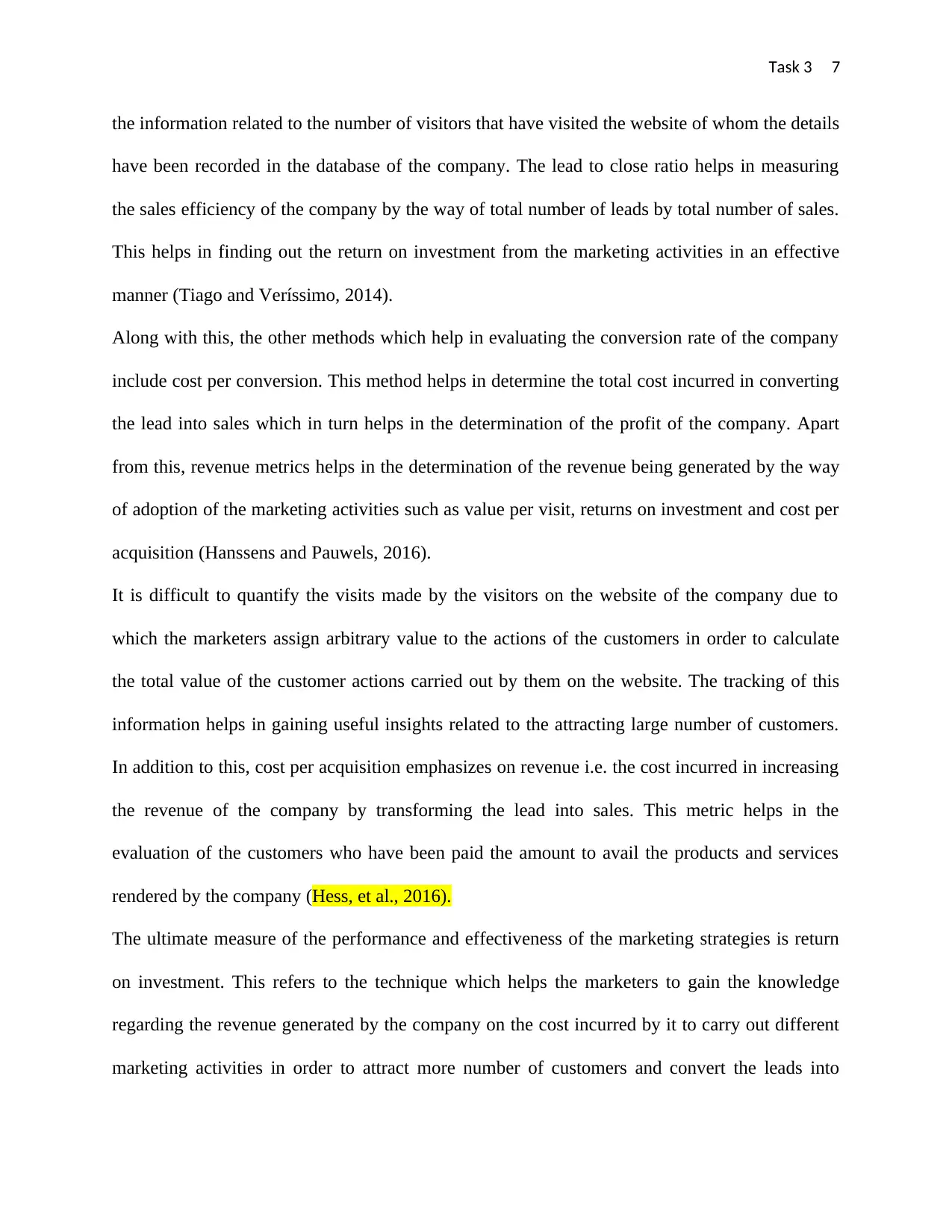
Task 3 7
the information related to the number of visitors that have visited the website of whom the details
have been recorded in the database of the company. The lead to close ratio helps in measuring
the sales efficiency of the company by the way of total number of leads by total number of sales.
This helps in finding out the return on investment from the marketing activities in an effective
manner (Tiago and Veríssimo, 2014).
Along with this, the other methods which help in evaluating the conversion rate of the company
include cost per conversion. This method helps in determine the total cost incurred in converting
the lead into sales which in turn helps in the determination of the profit of the company. Apart
from this, revenue metrics helps in the determination of the revenue being generated by the way
of adoption of the marketing activities such as value per visit, returns on investment and cost per
acquisition (Hanssens and Pauwels, 2016).
It is difficult to quantify the visits made by the visitors on the website of the company due to
which the marketers assign arbitrary value to the actions of the customers in order to calculate
the total value of the customer actions carried out by them on the website. The tracking of this
information helps in gaining useful insights related to the attracting large number of customers.
In addition to this, cost per acquisition emphasizes on revenue i.e. the cost incurred in increasing
the revenue of the company by transforming the lead into sales. This metric helps in the
evaluation of the customers who have been paid the amount to avail the products and services
rendered by the company (Hess, et al., 2016).
The ultimate measure of the performance and effectiveness of the marketing strategies is return
on investment. This refers to the technique which helps the marketers to gain the knowledge
regarding the revenue generated by the company on the cost incurred by it to carry out different
marketing activities in order to attract more number of customers and convert the leads into
the information related to the number of visitors that have visited the website of whom the details
have been recorded in the database of the company. The lead to close ratio helps in measuring
the sales efficiency of the company by the way of total number of leads by total number of sales.
This helps in finding out the return on investment from the marketing activities in an effective
manner (Tiago and Veríssimo, 2014).
Along with this, the other methods which help in evaluating the conversion rate of the company
include cost per conversion. This method helps in determine the total cost incurred in converting
the lead into sales which in turn helps in the determination of the profit of the company. Apart
from this, revenue metrics helps in the determination of the revenue being generated by the way
of adoption of the marketing activities such as value per visit, returns on investment and cost per
acquisition (Hanssens and Pauwels, 2016).
It is difficult to quantify the visits made by the visitors on the website of the company due to
which the marketers assign arbitrary value to the actions of the customers in order to calculate
the total value of the customer actions carried out by them on the website. The tracking of this
information helps in gaining useful insights related to the attracting large number of customers.
In addition to this, cost per acquisition emphasizes on revenue i.e. the cost incurred in increasing
the revenue of the company by transforming the lead into sales. This metric helps in the
evaluation of the customers who have been paid the amount to avail the products and services
rendered by the company (Hess, et al., 2016).
The ultimate measure of the performance and effectiveness of the marketing strategies is return
on investment. This refers to the technique which helps the marketers to gain the knowledge
regarding the revenue generated by the company on the cost incurred by it to carry out different
marketing activities in order to attract more number of customers and convert the leads into
Paraphrase This Document
Need a fresh take? Get an instant paraphrase of this document with our AI Paraphraser
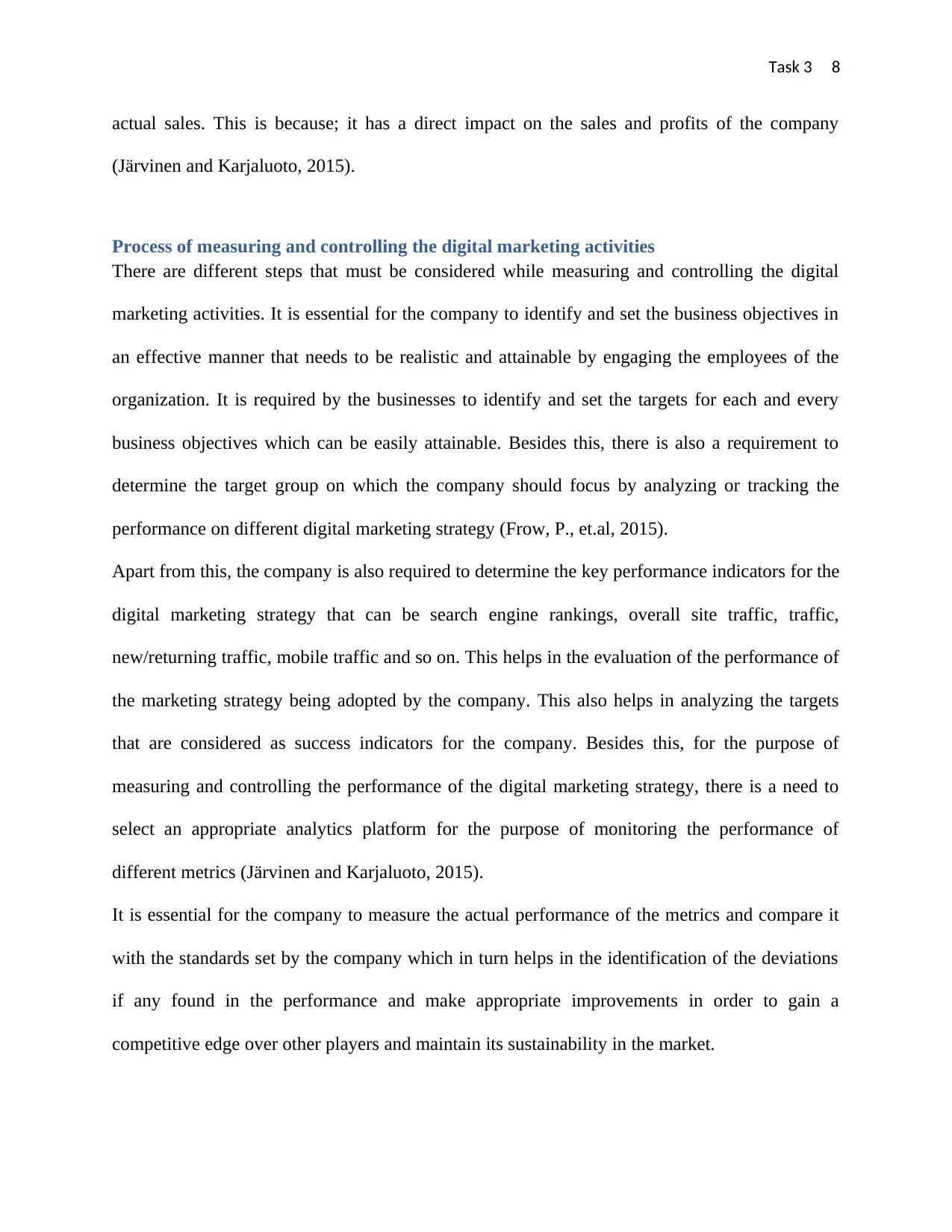
Task 3 8
actual sales. This is because; it has a direct impact on the sales and profits of the company
(Järvinen and Karjaluoto, 2015).
Process of measuring and controlling the digital marketing activities
There are different steps that must be considered while measuring and controlling the digital
marketing activities. It is essential for the company to identify and set the business objectives in
an effective manner that needs to be realistic and attainable by engaging the employees of the
organization. It is required by the businesses to identify and set the targets for each and every
business objectives which can be easily attainable. Besides this, there is also a requirement to
determine the target group on which the company should focus by analyzing or tracking the
performance on different digital marketing strategy (Frow, P., et.al, 2015).
Apart from this, the company is also required to determine the key performance indicators for the
digital marketing strategy that can be search engine rankings, overall site traffic, traffic,
new/returning traffic, mobile traffic and so on. This helps in the evaluation of the performance of
the marketing strategy being adopted by the company. This also helps in analyzing the targets
that are considered as success indicators for the company. Besides this, for the purpose of
measuring and controlling the performance of the digital marketing strategy, there is a need to
select an appropriate analytics platform for the purpose of monitoring the performance of
different metrics (Järvinen and Karjaluoto, 2015).
It is essential for the company to measure the actual performance of the metrics and compare it
with the standards set by the company which in turn helps in the identification of the deviations
if any found in the performance and make appropriate improvements in order to gain a
competitive edge over other players and maintain its sustainability in the market.
actual sales. This is because; it has a direct impact on the sales and profits of the company
(Järvinen and Karjaluoto, 2015).
Process of measuring and controlling the digital marketing activities
There are different steps that must be considered while measuring and controlling the digital
marketing activities. It is essential for the company to identify and set the business objectives in
an effective manner that needs to be realistic and attainable by engaging the employees of the
organization. It is required by the businesses to identify and set the targets for each and every
business objectives which can be easily attainable. Besides this, there is also a requirement to
determine the target group on which the company should focus by analyzing or tracking the
performance on different digital marketing strategy (Frow, P., et.al, 2015).
Apart from this, the company is also required to determine the key performance indicators for the
digital marketing strategy that can be search engine rankings, overall site traffic, traffic,
new/returning traffic, mobile traffic and so on. This helps in the evaluation of the performance of
the marketing strategy being adopted by the company. This also helps in analyzing the targets
that are considered as success indicators for the company. Besides this, for the purpose of
measuring and controlling the performance of the digital marketing strategy, there is a need to
select an appropriate analytics platform for the purpose of monitoring the performance of
different metrics (Järvinen and Karjaluoto, 2015).
It is essential for the company to measure the actual performance of the metrics and compare it
with the standards set by the company which in turn helps in the identification of the deviations
if any found in the performance and make appropriate improvements in order to gain a
competitive edge over other players and maintain its sustainability in the market.
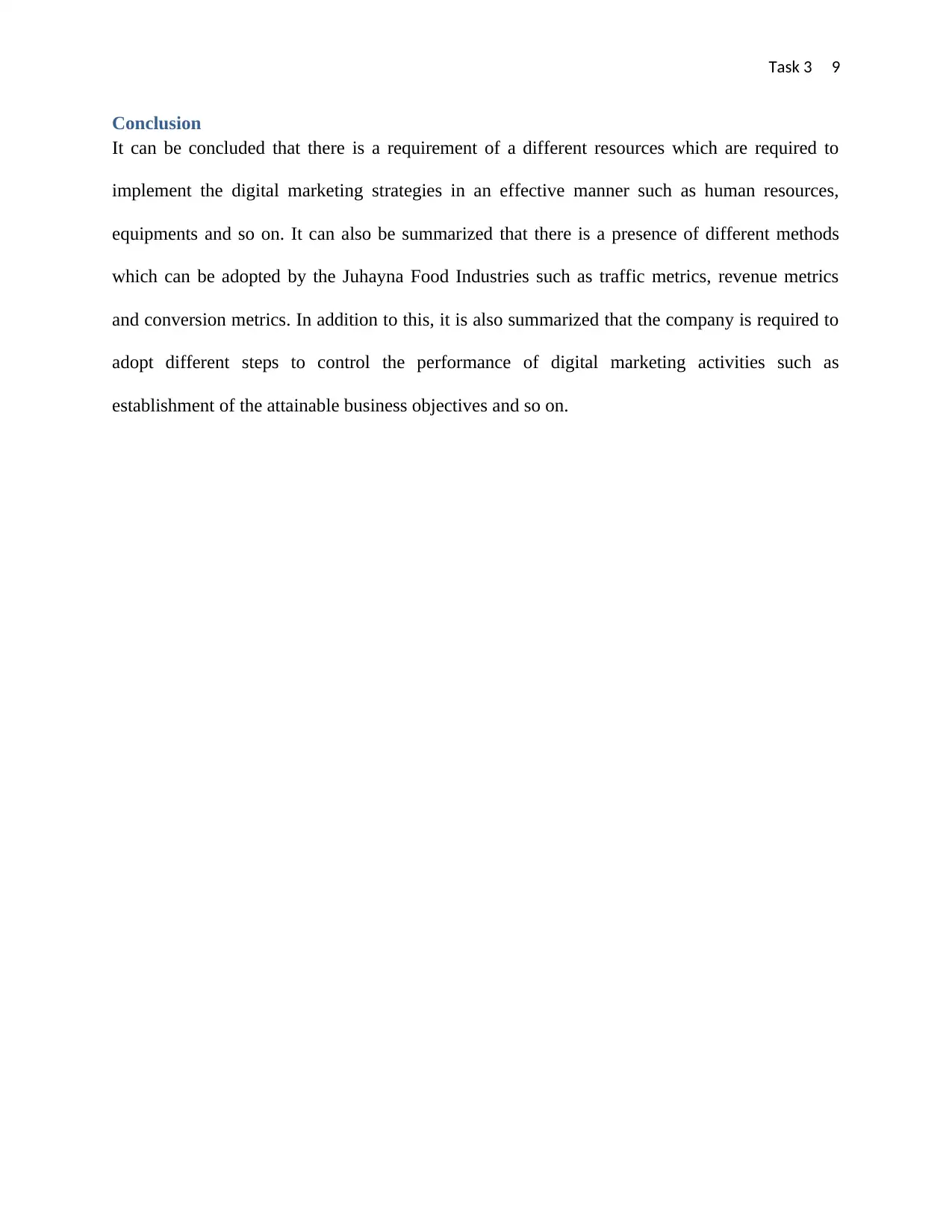
Task 3 9
Conclusion
It can be concluded that there is a requirement of a different resources which are required to
implement the digital marketing strategies in an effective manner such as human resources,
equipments and so on. It can also be summarized that there is a presence of different methods
which can be adopted by the Juhayna Food Industries such as traffic metrics, revenue metrics
and conversion metrics. In addition to this, it is also summarized that the company is required to
adopt different steps to control the performance of digital marketing activities such as
establishment of the attainable business objectives and so on.
Conclusion
It can be concluded that there is a requirement of a different resources which are required to
implement the digital marketing strategies in an effective manner such as human resources,
equipments and so on. It can also be summarized that there is a presence of different methods
which can be adopted by the Juhayna Food Industries such as traffic metrics, revenue metrics
and conversion metrics. In addition to this, it is also summarized that the company is required to
adopt different steps to control the performance of digital marketing activities such as
establishment of the attainable business objectives and so on.
⊘ This is a preview!⊘
Do you want full access?
Subscribe today to unlock all pages.

Trusted by 1+ million students worldwide
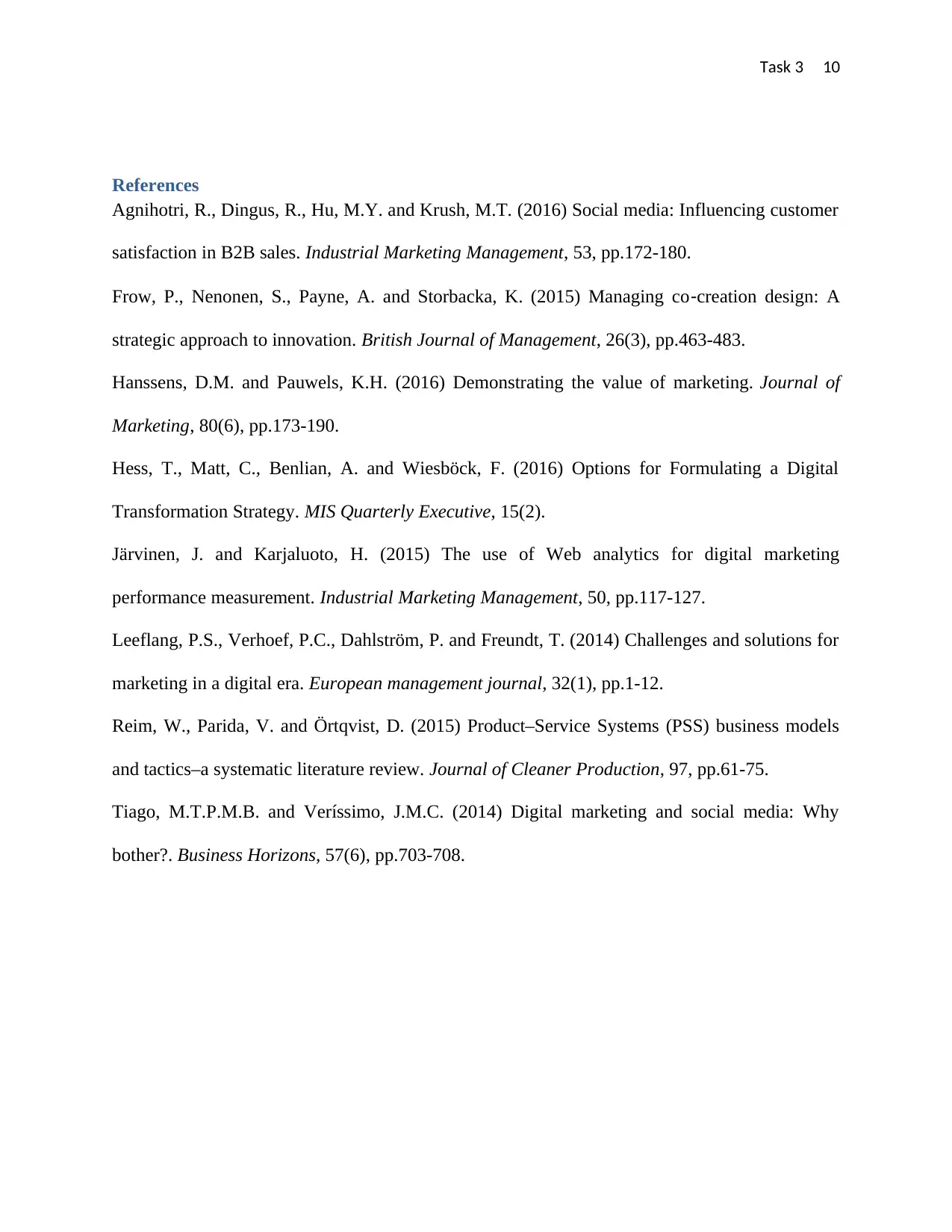
Task 3 10
References
Agnihotri, R., Dingus, R., Hu, M.Y. and Krush, M.T. (2016) Social media: Influencing customer
satisfaction in B2B sales. Industrial Marketing Management, 53, pp.172-180.
Frow, P., Nenonen, S., Payne, A. and Storbacka, K. (2015) Managing co‐creation design: A
strategic approach to innovation. British Journal of Management, 26(3), pp.463-483.
Hanssens, D.M. and Pauwels, K.H. (2016) Demonstrating the value of marketing. Journal of
Marketing, 80(6), pp.173-190.
Hess, T., Matt, C., Benlian, A. and Wiesböck, F. (2016) Options for Formulating a Digital
Transformation Strategy. MIS Quarterly Executive, 15(2).
Järvinen, J. and Karjaluoto, H. (2015) The use of Web analytics for digital marketing
performance measurement. Industrial Marketing Management, 50, pp.117-127.
Leeflang, P.S., Verhoef, P.C., Dahlström, P. and Freundt, T. (2014) Challenges and solutions for
marketing in a digital era. European management journal, 32(1), pp.1-12.
Reim, W., Parida, V. and Örtqvist, D. (2015) Product–Service Systems (PSS) business models
and tactics–a systematic literature review. Journal of Cleaner Production, 97, pp.61-75.
Tiago, M.T.P.M.B. and Veríssimo, J.M.C. (2014) Digital marketing and social media: Why
bother?. Business Horizons, 57(6), pp.703-708.
References
Agnihotri, R., Dingus, R., Hu, M.Y. and Krush, M.T. (2016) Social media: Influencing customer
satisfaction in B2B sales. Industrial Marketing Management, 53, pp.172-180.
Frow, P., Nenonen, S., Payne, A. and Storbacka, K. (2015) Managing co‐creation design: A
strategic approach to innovation. British Journal of Management, 26(3), pp.463-483.
Hanssens, D.M. and Pauwels, K.H. (2016) Demonstrating the value of marketing. Journal of
Marketing, 80(6), pp.173-190.
Hess, T., Matt, C., Benlian, A. and Wiesböck, F. (2016) Options for Formulating a Digital
Transformation Strategy. MIS Quarterly Executive, 15(2).
Järvinen, J. and Karjaluoto, H. (2015) The use of Web analytics for digital marketing
performance measurement. Industrial Marketing Management, 50, pp.117-127.
Leeflang, P.S., Verhoef, P.C., Dahlström, P. and Freundt, T. (2014) Challenges and solutions for
marketing in a digital era. European management journal, 32(1), pp.1-12.
Reim, W., Parida, V. and Örtqvist, D. (2015) Product–Service Systems (PSS) business models
and tactics–a systematic literature review. Journal of Cleaner Production, 97, pp.61-75.
Tiago, M.T.P.M.B. and Veríssimo, J.M.C. (2014) Digital marketing and social media: Why
bother?. Business Horizons, 57(6), pp.703-708.
1 out of 10
Related Documents
Your All-in-One AI-Powered Toolkit for Academic Success.
+13062052269
info@desklib.com
Available 24*7 on WhatsApp / Email
![[object Object]](/_next/static/media/star-bottom.7253800d.svg)
Unlock your academic potential
Copyright © 2020–2025 A2Z Services. All Rights Reserved. Developed and managed by ZUCOL.




